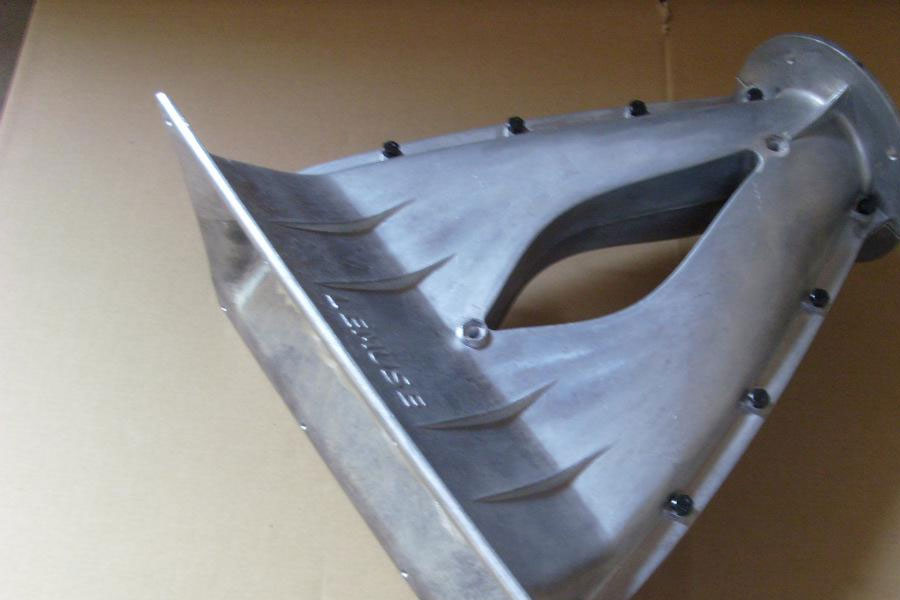1600 tons die casting machine produces crankcase, and the treatment method of internal pore defects
1. Main issues
A large number of pores appear after the joint surface of the crankcase oil pan is processed. The size of the pores is 0.8-1.5mm, the number ranges from 5-15, and the cavity leakage rate is about 20%.
2. Product and mold structure analysis
2.1 Product structure analysis
In order to understand the product structure more clearly, we first use software to detect the wall thickness of the product. The maximum wall thickness on the product is 8mm, and the general wall thickness is 4mm.
2.2 Mold structure analysis
The existing mold plan of the product mainly uses two main runners to pour in from both sides of the product, and then fill the entire part of the product.
3. Reason analysis
3.1 Analysis of the causes of stomata
First of all, we analyze the causes of pores from the man-machine material method.
3.1.1 The wall thickness is too thick…
After checking the blank and product 3D, the wall thickness of the oil pan joint surface (red area) of the crankcase part has reached 8mm, and the blank machining allowance is 1.2mm. Excessive wall thickness and excessive machining allowance are one of the reasons for the pores. .
3.1.2 Unreasonable mold design
Because the mold uses pouring on both sides of the product, the molten aluminum meets at the joint surface of the oil pan after passing through the two main runners, forming a hedge, causing entrainment in the purple area. In the mold design, there is no setting in this area. Exhaust groove, resulting in the gas cannot be discharged. This aspect is also one of the reasons for the formation of stomata.
3.1.3 Unreasonable setting of process parameters
The die-casting process parameters set during the production of this product are as follows: 1) The first-speed starting speed is 0.3m/s. The first-speed starting position is too fast and the gas in the pressure chamber cannot be discharged is also one of the reasons for the formation of pores in the product.
3.1.4 Unreasonable setting of spray and blowing time of the mold
The spray time on the joint surface of the oil pan is 3s, and the blowing time is 1s. Excessive spraying time and short blowing time, resulting in residual moisture on the mold is also one of the reasons for the formation of pores in the product.
4. Solution
4.1 Solutions for Excessive Wall Thickness
4.1.1 In view of the excessive thickness of the joint surface of the oil pan of the product, we improved it by optimizing the mold structure. That is, the place on the mold is made into a grid structure, and the machining allowance of the surface is reduced from 1.2mm to 0.7mm
4.2 Unreasonable solution to mold design
4.2.1 According to the analysis of the mold structure, a main sprue (the area on the left side of the figure below) is now blocked, and the oil pan joint area is made into multiple grid inserts for assembly. On the one hand, the grid Grid inserts can slow down the impact of molten aluminum meeting there. On the other hand, the gap between the inserts forms a channel for exhaust.
4.3 Solutions to unreasonable process parameter settings
4.3.1 Reset the first-speed speed and change the previous first-speed speed from 0.3m/s to 0.2m/s. Thus, the air holes in the pressure chamber have more time to be discharged from the pressure chamber and not brought into the mold cavity.
4.4 The solution to the unreasonable setting of the spray and blowing time of the mold
4.4.1 Reset the spray and blowing time of the mold,
Change the original spraying time of 3s and blowing time of 1s to spraying time of 1s and blowing time of 2s. The moisture on the mold is blown dry.
5. Improved effect
5.1 After the implementation of the above measures, the product quality status is shown in the figure. The unqualified rate of pores on the joint surface of the crankcase oil pan has been reduced from 20% to 0.5% after being machined by the customer.
5.2 Comparison before and after product improvement
6. Summary
The pore quality problem of die castings is widespread in the foundry industry. It is necessary to analyze the products, molds, and process parameters one by one to find solutions to improve the yield of products.
